This post looks at the conflict in Togoland during the First World War, and is the first in a series of blogs that will look at different aspects of the war in Africa. The first British shots of the First World War were fired in West Africa and the last German troops surrendered after armistice in East Africa; the First World War effectively started and finished in Africa.
The war in Africa is often overlooked, and was fought very differently to the war in Europe. With a lack of transport and infrastructure, troops and supplies had to be moved on foot by porters; most of the interior of Africa had not been mapped in detail, so troops were marching into the unknown; and whereas the front in France may have moved a few feet a year, in Africa troops covered hundreds of miles a month to engage with the enemy. The fighting mainly took place within Germany’s colonial holdings, with the Union of South Africa fighting under the British flag in German South West Africa, and the British and French fighting in Togoland, the Cameroons and then finally in German East Africa.
Togoland would be the first Entente victory of the war. It was conquered in around three weeks. On 5 August 1914, the Committee of Imperial Defence recommended that troops from the Gold Coast and Sierra Leone should be used for offensive purposes against Togoland (CAB 45/110). Their aim was to destroy the important wireless station at Kamina, which linked Berlin to its African colonies, to shipping in the South Atlantic, and with South America. [ref] 1. Strachan. H (2004). The First World War in Africa, Oxford University Press, USA (p.13). [/ref]
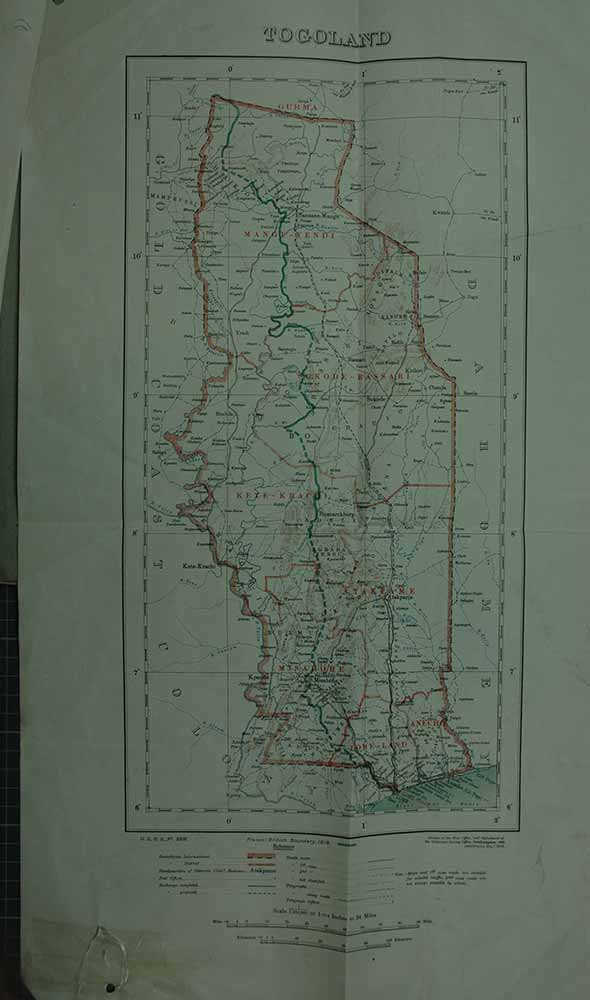
Map of Togoland (catalogue reference: CAB 45/110)
On 6 August the Cabinet met and approved the operation. The Secretary of State for the Colonies instructed the officer administrating the government of the Gold Coast to inform the governor of Togoland, von Doering, that the British government would not entertain his proposal that the German territories remain neutral under the terms of the Congo Act. This act was ratified by the Treaty of Berlin in 1885 and allowed any power within the Congo basin to declare itself neutral.[ref] 2. Strachan. H (2004), The First World War in Africa, Oxford University Press, USA (p.14) [/ref] The plea was seen as what it was: a reflection of German weakness. An account written by a German officer showed that they did not doubt that the British and French would conquer the colony, with the British marching from the West and the French on the Northern and Eastern frontiers (CAB 45/111). Correspondence shows that the surrender of Togoland was demanded on 7 August.
On 8 August, the capital Lome and the southern section of Togoland, was surrendered without fight. The French were contacted and asked to cooperate in an attack on Kamina, which they duly agreed too. By 12 August, three companies of the Gold Coast Regiment were at Ketekrachi, and French troops in the north were advancing on Sansane-Mangu. Captain Bryant, acting commander of the Gold Coast Regiment (and given the temporary rank of Lieutenant-Colonel to make him senior to the French commander), started the move on Kamina on 15 August. Bryant requested the use of local levies from Ashanti and Awuna, which was refused with the suggestion that he should wait for reinforcement from Nigeria. On 16 August, Ekuni was captured and Agbeluhowe had been reached. By 21 August, Bryant had concentrated his force at Nuatya, and was sending out strong patrols towards the Akhla River (CAB 45/110).
There were a number of smaller actions fought between 8 and 21 August. Then on 22 August heavy fighting broke out on the Chra River, where the enemy were entrenched (cab 45/110).
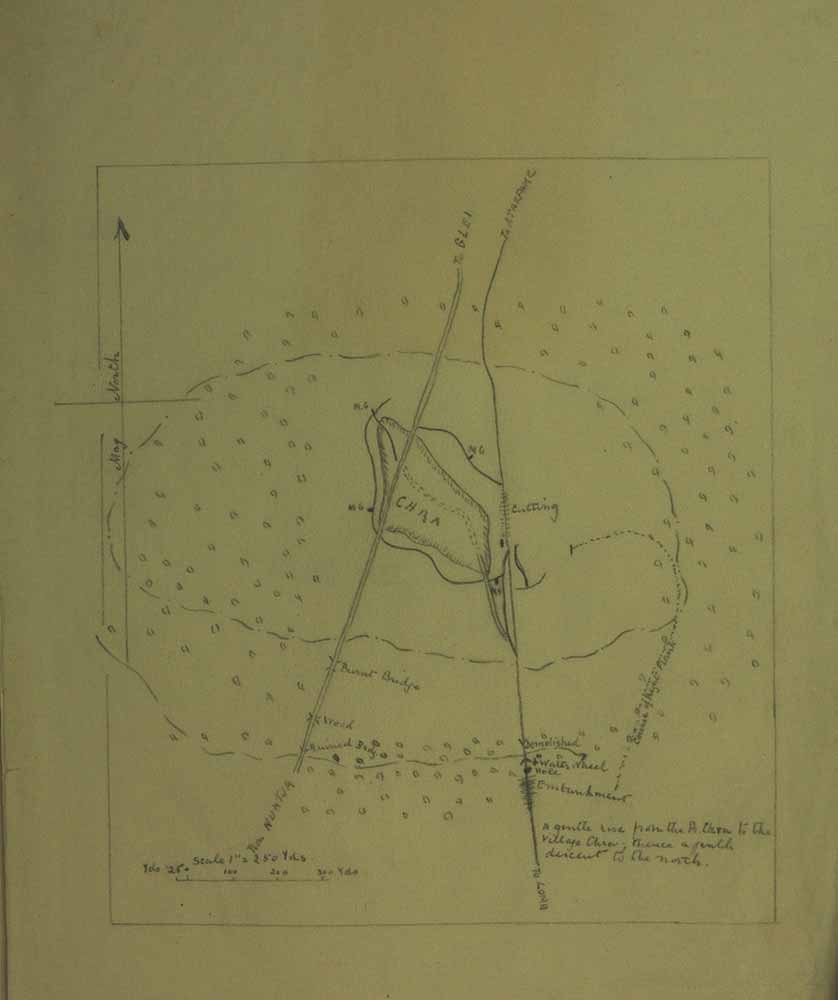
Map of Chra (catalogue reference: WO 32/5788)
An account by Sergeant-Major Stober, a reserve officer, shows that von Doring decided to take a defensible position on the Southern frontier of the village of Chra; they prepared good positions between the road and railway. The British and French arrived and attacked the whole front of the German positions, but were held off by well-ordered fire from the trenches. There were losses on both sides. Firing ceased as night came, but the German command gave orders to withdraw to Kamina.
On 26 August Bryant reported that the wireless station at Kamina had been destroyed by the Germans, and that a flag of truce had been sent on 25 August. The Germans offered terms, but Bryant was clear that they must surrender unconditionally, which they did. Similarly, Stober’s account shows that when his troops arrived the wireless towers were down and the engine house was on fire; von Doring had surrendered. British and French forces entered Kamina at 08:00 on 27 August, effectively ending the war in Togoland (CAB 45/110).
The campaign in Togoland was fought using African troops and carriers with British officers, and the records show details of the wounded and dead. The record also includes some details on French and German carriers and Europeans.
Colonial considerations had taken precedence over the wider war effort. Manpower had been a problem for von Doering and ultimately the Kamina position was too extensive to defend with the number of troops available. Protracted resistance and its effects would have likely set back the economic benefits of the German possession.[ref] 3. Strachan. H (2004), The First World War in Africa, Oxford University Press, USA (p.17) [/ref]
The fighting moved on to the Cameroons, which will be the subject of the next blog in the series.
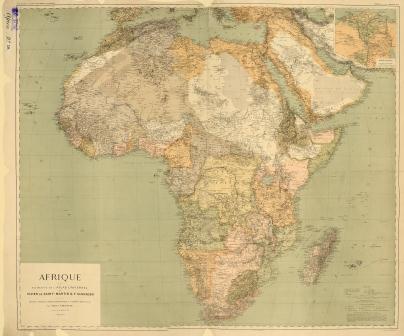
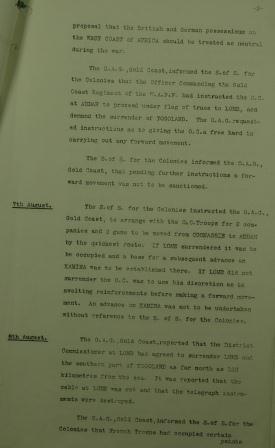

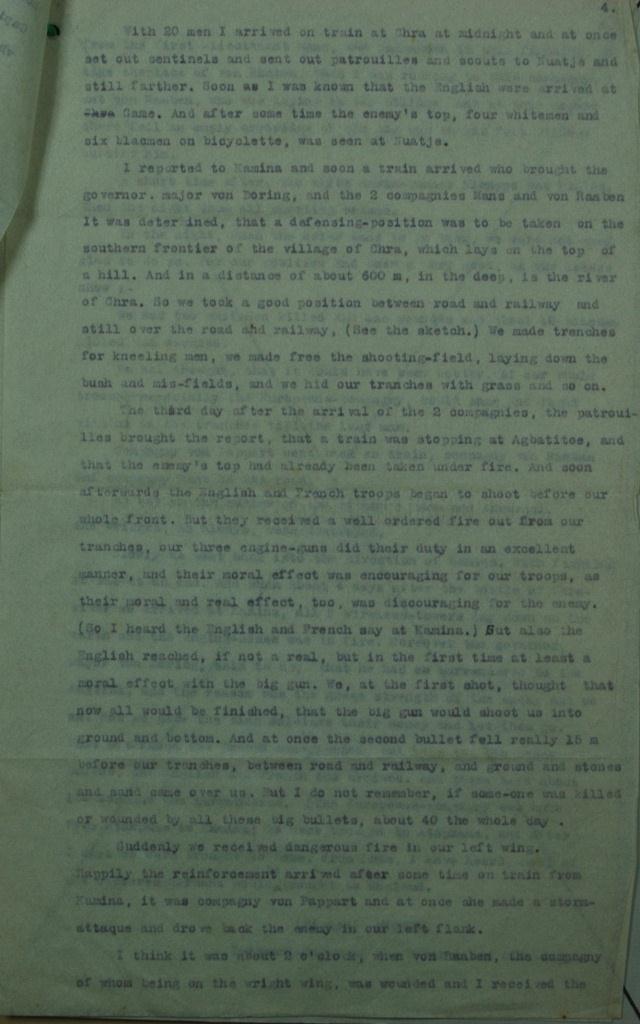

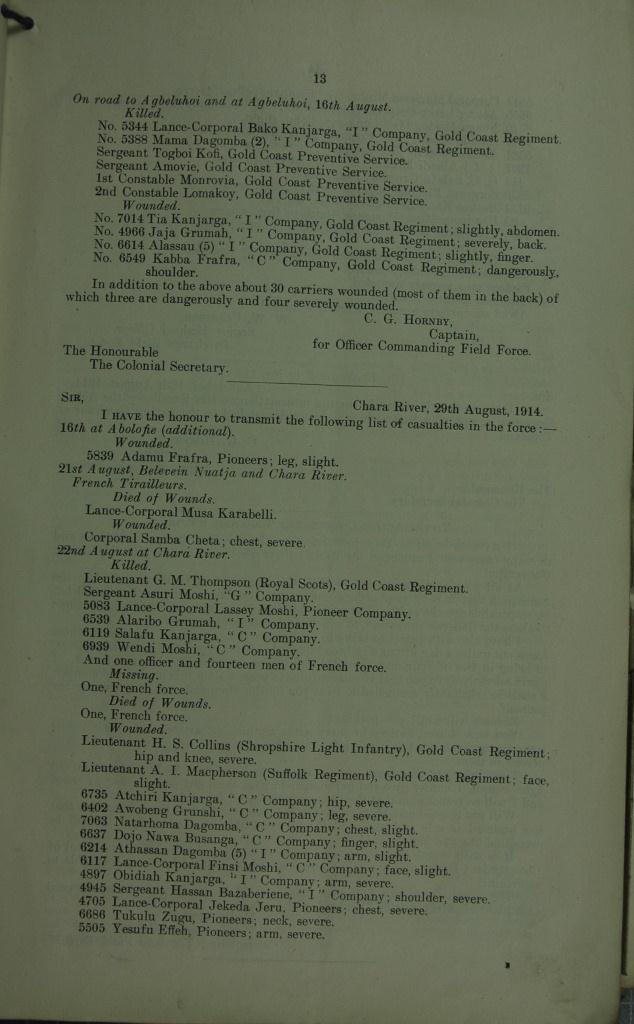

[…] This post looks at the conflict in Togoland during the First World War, and is the first in a series of blogs that will look at different aspects of the… Go to Source […]
As it has been very interesting to me that all the wars fought in Africa south of the Sahara have been omitted from most books/displays/commemorations, I wrote it all up for a UNESCO publication.
Of course, except for their officers, 90+% of the soldiers/ and their ‘carriers’ were Africans, so who cares how many millions died; or whether any were paid; if the widows received anything?
Actually Anne Samson, Ross Anderson, the Jewell family and a number of others, including myself, have written on the E.A. Campaign. Now that the commemoration of WWI is in full swing at least these stories and accounts are beginning to surface. Check on any of these names.
Ann Crichton-Harris
Many thanks Marika and Ann for your comments and for highlighting others researchers that are looking different aspects of the Great War in Africa. Hopefully your comments will help direct anyone reading this post towards other works and resources. It is worth mentioning that there will be a number of events held at the archives this year looking at The First World War in Africa, the first being 18 February – War diaries and the wider picture. https://www.eventbrite.co.uk/e/the-first-world-war-in-africa-war-diaries-and-the-wider-picture-tickets-19837915740
The British officer recorded in the casualty list, Lieutenant George Masterman Thompson of The Royal Scots (Lothian Regiment), was killed on Saturday 22nd August 1914 in the attack on Chra and so was the first British officer killed in the First World War. There is a brass plague to his memory in St. John’s Church, Burley, Hampshire, the home of his widowed mother, Agnes Thompson. It includes the statement: “In honour also of Sergeant Asuri Moshi and a Private of the Gold Coast Regiment, a Sergeant , 2 Corporals and 9 Tirailleurs (Senegalese) who bravely followed their young leader and laid down their lives in the defence of his body”. So deep in the New Forest some African soldiers are still remembered.
Thank you for your comments Richard, I did not know about the church in Burley and it is good to know that some African soldiers are still remembered so far away from their home!
We were just commenting the other day that there should be more written about the War in Africa. This blog series may just get some new books underway and published on the subject. Many thanks for publishing this blog.
Thank you for your comments Sher, hopefully the series will help draw out some of the stories that need telling and inspire others to research and write about the war in Africa.
I hope people will read Laszlo Z. Karvalics (ed) Information History of the First World War, Paris: L’Harmattan, 2016, which has my article in it. on the ‘Black Hole’ of information.
For anyone interested in seeing what is available on the First World War in Africa, visit (and join) http://www.gweaa.com – The Great War in Association is a hub of information on the First World War in Africa – it contains ‘In Memory’ lists (at different levels of completion) of all known people to have been involved in the war – survivors and those who died irrespective of background etc. Also all known publications on the war in Africa are listed.
There is also an annual conference on WW1 in Africa – we’re having our 5th at TNA on 3 and 4 May 2016. It’s going to be the most diverse to date.
TNA is also hosting an afternoon of talks on WW1 in Africa on 18 Feb. If you’re in the neighbourhood, come along and discover what is being done…
This is interesting… What at all did the Europeans see in the Togoland that made them wage war on us… Why Should the Western Togoland be added to Gold Coast so called Ghana without any laid down constitution… today we the people of Western Togoland say enough is enough we want our Self Rule.